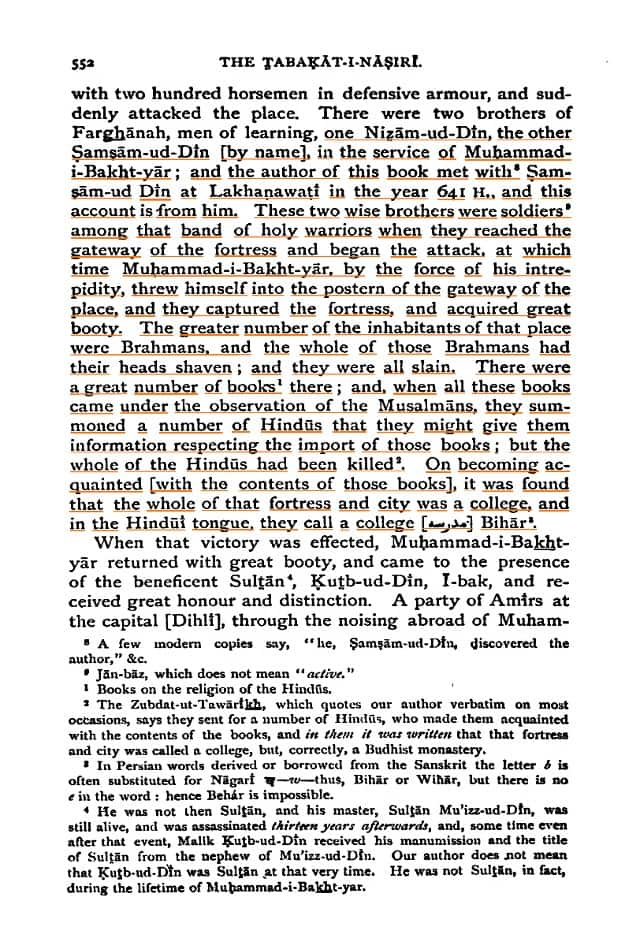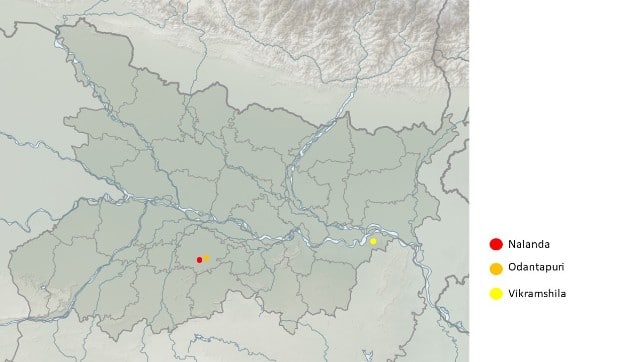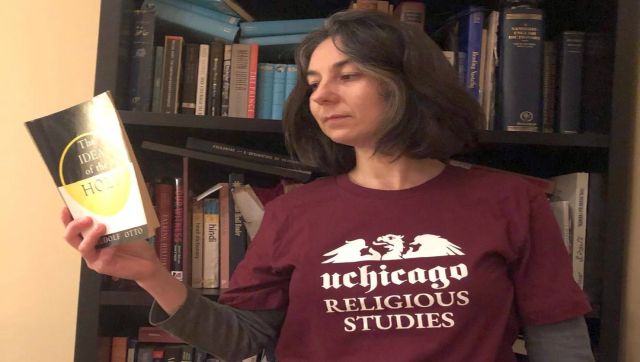Following up on the last article on history-phobia, in this essay I provide a rejoinder to a set of non-scholarly apologetic defence for Islamic invaders, especially Bakhtiyar Khalji, by ‘eminent’ historian Audrey Truschke. Unlike a scholarly rejoinder, she began with mudslinging against Anand Ranganathan and Vikram Sampath. She calls the latter ‘plagiarist’ yet again even though the honourable High Court of Delhi had found her allegations holding no water and instructed her not to tweet anything defamatory on such lines . In her long narration through a thread of tweets, she begins by saying, “ There seems to be a claim of a single Islamic conquest of India. That’s wrong . “Real story — There were many Indo-Muslim dynasties who ruled parts of South Asia over the centuries. Some came from outside the subcontinent, and others did not. Nobody ever conquered all of India.” This was a wrong portrayal of what Sampath paraphrased from Will Durant’s book, The Story of our Civilization . Durant nowhere indicates of a single Islamic Conquest, but he means a series of raids carried across by Mahmud of Ghazni, Mohammed Ghori followed by the rule of Qutb-ud-din Aibak, etc, that incurred so much atrocity that the land of northern Bharat began to smell of gore (I hope that eminent historians read it as metaphor and don’t take it literally). He states many reasons using primary sources for it to be called bloodiest, of which a couple of them that stand out are: “ How Firoz Shah paid a reward for 180,000 Hindu heads during the campaign of Bengal and how Sultan Ahmad Shah feasted for three days whenever the number of slain Hindus in his territory reached 20,000 in day during his reign .” Assistant Professor Audrey next takes a jibe for the mention of the word, “ Khalji is a dynastic name, so this would be a bit like saying ‘Tudor’ or ‘Mughal’ did something. Which Tudor? Which Mughal ?” It was a highly unscholarly argument because it was clearly mentioned by Sampath that, “(…) we name a town near Nalanda after him.” Of course, he is referring to the town named Bakhtiyarpur, so it is already indicated which Khalji is being spoken about. Further, Truschke points to one her paper, “ The Power of the Islamic Sword in Narrating the Death of Indian Buddhism ,” which categorically focuses on building anti-thesis of thesis that “Islam killed Indian Buddhism.” I’m soon going to take up the task of complete “Purva-Paksha” of this paper anytime soon but for the matter of relevance and context, I’m limiting this essay specifically to investigate her thesis (reflected in above mentioned paper) that Bakhtiyar Khalji mustn’t be held responsible for destruction of Nalanda for the lack of evidence and the educational institution continued to operate even after the alleged destruction by the former. After going through the whole paper, it appears more like an apology for violence and vandalism committed by Islamic invaders in India. So, let’s focus on the specific issues intended for this essay. Did Bakhtiyar Khalji destroy Nalanda? Most of Audrey’s ‘evidence’ for this claim comes from “ Tabaqat-i Nasiri ,” (1260 AD) written by Persian historian Minhaj al-Siraj Juzjani. The reason she mentions (paraphrased by me) are as under:
- Minhaj narrated the tale of the destruction by a person from Ferghana, “Sams-Ud-Din,” around fifty years after the incident is said to have happened, hence this can’t be considered as evidence.
- The place is not specifically identified as Nalanda and scholars misinterpret Juzjani’s “fortified city” as Bihar Sharif. She points it to be a mistake of trying to read out Vihara as Bihar like how Brahmins have been seen as Buddhists just for the shaved head.
- Most of the Muslim chroniclers exaggerated the stories and Juzjani was no different.
Let’s look at the above stated points one by one. But before that do read the exact excerpt from the translation of Nabaqat-i Nasiri done by Ravety (Figure 1). Audrey has shown objection to Ravety concluding that the books to be that of “Hindus” which is not mentioned in the Persian text. Ravety has done so by adding a footnote (note Figure 1). As an academician and scholar, Audrey was expected to understand that Ravety did not mistranslate but used footnotes to give an understanding of what those books could be. For certain those books were not Abrahamic in nature. Would she care to explain what the nature of those books was if not “Hindu?” [caption id=“attachment_11737461” align=“alignnone” width=“640”] Figure 1: Tabakat-i-Nasiri, vol 1. trans. H. G. Raverty[/caption] Going back to the main point of focus, her problem that Minhaj was not the witness to the incident and hence his account can’t be seen as evidence is a bit of a strawman. Minhaj has clearly relied on the account of a person who happens to be a comrade in the campaign of Bakhtiyar Khalji. From the scholarly point of view, you can’t reject this account until you have proven as below:
Figure 1: Tabakat-i-Nasiri, vol 1. trans. H. G. Raverty[/caption] Going back to the main point of focus, her problem that Minhaj was not the witness to the incident and hence his account can’t be seen as evidence is a bit of a strawman. Minhaj has clearly relied on the account of a person who happens to be a comrade in the campaign of Bakhtiyar Khalji. From the scholarly point of view, you can’t reject this account until you have proven as below:
- Minhaj had ill intentions to cook up a story
- Minhaj never met Nizam-Ud-Din and Sams-Ud-Din
- Nizam-Ud-Din and Sams-Ud-Din and were not the part of Khalji’s campaign
To establish a historical account of a period one would always take the nearest account, and when no two parties involved (Turko-Afghans and Biharis) disagree on the given account, one needs to prove it wrong empirically to change a historical consensus. The arguments used by Audrey shall only bring more problem for Islamic studies as the biography of Prophet Muhammad (PBUH) is based on hearsay. The account that we have as hardcopies are of Ibn Hisham, who wrote the text around two centuries after the death of Prophet Muhammad (PBUH) by basing his narratives on works (oral tradition) of Ibn Ishaq, too supposedly lived almost a century after the Prophet. When the whole Islamic history based on such accounts is regarded as truth, why should we put in place a different parameter for the Nalanda destruction? She also sees a problem in Brahmins being perceived as Buddhists for the shaved heads. This further weakens her ground. To prove her case that Islam did not lead to destruction of Buddhism is India, she builds a case that Nalanda was very much a generic Hindu place in nature, wherein Buddhist traditions too were studied. Somehow this has been a Marxist case of history that Nalanda is exclusively Buddhist in nature and Buddhist traditions are not part of Hindu tradition (wrong thesis, though). That apart, it also must be brought to light that Buddhism had almost become extinct in Afghanistan by then. In fact, the Marxist historian
Satish Chandra too explains
that by the rise of the Ghurid dynasty, Islamisation was complete in the 11th century. And more than anything one needs to understand that for the whole Islamic world of that period, the idolators of Hind were Hindus, rather it was a race. For example, Al-Beruni writes in 11th century, “
In the mountains which form the frontier of India towards the west there are tribes of the Hindus, or of people near akin to them — rebellious savage races — which extend as far as the farthermost frontiers of the Hindu race.
” And all the teachers to them in Hind were Brahmins. Audrey’s second point of argument is about proximity and location of the place. She writes, “Last, we must make a leap of faith regarding the identity of Juzjani’s ‘fortified city.’ Most modern scholars understand the fortified city in the above passage to be Bihar Sharif, including its associated monastery of Odantapuri (Uddandapura). Like the shift from Brahmins to Buddhists, this identification is reasonable but lacks concrete evidence. Indeed, the precise location of Odantapuri has not been established.” Interestingly, the person hinted in her
tweet thread
and named in the paper, to make a case for “non-destruction” of Nalanda itself plays against her thesis.
According to Dharmasvamin
, Bihar and Bengal witnessed the attacks of Bakhtiyar Khalji between 1193 to 1205 AD. He specifies the destruction of Vikramshila to have happened in 1199-1200 AD. It must be noted that he had visited the place in 1234 AD, i.e., around four decades after the “destruction of Nalanda” by Bakhtiyar Khalji (antithesis of Truschke).
He even talks of destruction of Odantapuri by Khalji
and mentions it of have become the residence of Turk military commander. If one notes the geography, it becomes evident that Nalanda falls first on the way (though a bit of a detour) to Bengal followed by Odantapuri and Vikramshila (Refer Figure 2). If one superimposes the account of Minhaj over the observations of Dharmasvamin, it becomes evident that Bakhtiyar Khalji had ransacked Nalanda in 1193 AD. [caption id=“attachment_11737511” align=“alignnone” width=“640”] Figure 2: Map of Bihar showing Nalanda, Odantapuri and Vikramshila[/caption] Audrey writes that, “In any case, if Muhammad bin Bakhtiyar did hit Nalanda, it recovered. Nalanda operated as a monastery and place of learning for decades afterwards, even attracting visitors from Tibet in the 1230s (one visiting monk wrote about it).” But the monk (Dharmasvamin, discussed in paragraph above) she talks about gives a very different picture than what she wants us to see. According to him, Nalanda existed but only with the ghost of past glory. He describes that once Nalanda housed 7 temples, 14 big and 8 small monasteries but all were damaged by the Muslim invaders.
No one was there to look after them and make the offerings
with only 2 Viharas; Dha-na-ba & Ghu-na-ba existing in a serviceable condition. According to him thousands of monks had fled for the fear of Turks, but the chief abbot Rahula-sri-Bhadra, aged around 90 continued to stay who had chosen against fleeing. During Dharmasvamin’s visit, 70 monk scholars studied under the chief abbot. They were supported by the king Buddhaesna of Bodh-Gaya and a rich Brahmin disciple Jayadeva who lived in Odantapuri (now Bihar Sharif). Audrey’s dishonest opinion is exposed by the account of the same monk, Dharmasvamin, who she presented as the evidence giver for the existence of Nalanda. He points out the reason for only partial destruction of Nalanda.
According to him it was a superstitious belief of Muslim invaders that they couldn’t destroy Nalanda completely
. Dharmasvamin explains that during their earlier despoliations, the Muslims had destroyed the temple of Jnananatha within the precincts of Nalanda and carried away its stones probably with intent to build a mosque in Odantapuri. They had desecrated the image by throwing filth at it following which one of the Muslim soldiers died of the colic pain the same evening. As expressed by the Monk, a sense of fear got engraved among them and they began to refrain from planning any further attack on Nalanda. But a truthful analysis of event lets us know that the place wasn’t destroyed completely for following reasons (
as mentioned by the translator of Chag lo tsa-ba Chos-rje-dpal, Biography of Dharmasvamin; George Roerich
):
Figure 2: Map of Bihar showing Nalanda, Odantapuri and Vikramshila[/caption] Audrey writes that, “In any case, if Muhammad bin Bakhtiyar did hit Nalanda, it recovered. Nalanda operated as a monastery and place of learning for decades afterwards, even attracting visitors from Tibet in the 1230s (one visiting monk wrote about it).” But the monk (Dharmasvamin, discussed in paragraph above) she talks about gives a very different picture than what she wants us to see. According to him, Nalanda existed but only with the ghost of past glory. He describes that once Nalanda housed 7 temples, 14 big and 8 small monasteries but all were damaged by the Muslim invaders.
No one was there to look after them and make the offerings
with only 2 Viharas; Dha-na-ba & Ghu-na-ba existing in a serviceable condition. According to him thousands of monks had fled for the fear of Turks, but the chief abbot Rahula-sri-Bhadra, aged around 90 continued to stay who had chosen against fleeing. During Dharmasvamin’s visit, 70 monk scholars studied under the chief abbot. They were supported by the king Buddhaesna of Bodh-Gaya and a rich Brahmin disciple Jayadeva who lived in Odantapuri (now Bihar Sharif). Audrey’s dishonest opinion is exposed by the account of the same monk, Dharmasvamin, who she presented as the evidence giver for the existence of Nalanda. He points out the reason for only partial destruction of Nalanda.
According to him it was a superstitious belief of Muslim invaders that they couldn’t destroy Nalanda completely
. Dharmasvamin explains that during their earlier despoliations, the Muslims had destroyed the temple of Jnananatha within the precincts of Nalanda and carried away its stones probably with intent to build a mosque in Odantapuri. They had desecrated the image by throwing filth at it following which one of the Muslim soldiers died of the colic pain the same evening. As expressed by the Monk, a sense of fear got engraved among them and they began to refrain from planning any further attack on Nalanda. But a truthful analysis of event lets us know that the place wasn’t destroyed completely for following reasons (
as mentioned by the translator of Chag lo tsa-ba Chos-rje-dpal, Biography of Dharmasvamin; George Roerich
):
- The establishment had not many stone structures, which could supply stone for the erection of mosques.
- It was too big to be thoroughly destroyed in one effort.
- Nalanda was not, like Vikramasila, on the highway leading from Delhi to Bengal, and so the work of completing its destruction required a special expedition.
- Of its numerous temples and monasteries, two monasteries were in a serviceable condition in 1235 AD. So, when the first avalanche of Muslim invasion was over, a few monks, about a hundred in number, returned with their head abbot to stay at the establishment, hoping that they would now be left undisturbed. Practically the whole province had been overrun by the Muslims and the constant danger of their harassment was present everywhere. Why then not stay in a place, which could at least afford some good accommodation for a limited number and was hallowed by its earlier associations?
But the invasions would soon begin and Dharmasvamin did witness one of them on his own. So, one can dig deeper and deeper into the texts of him only to get evidence that the places of study were under continual attack by the Muslim invaders, wherein libraries too were destroyed. It clearly shows that the massive attack of Islamic Invaders had weakened the Buddhist influence a big time. And this won’t be an exaggerated statement, even though not 100 percent true to say that “the invasion of Islamic forces led to the decline of Buddhist influence in Baharat.” It is unfortunate that we live in a time when even to talk about atrocities and genocides committed upon our ancestors gets labelled as propaganda, and bunch of lies. It is a big fall of academic discourse where it has become a tool to annotate everything wrong that has happened against Hindu civilisation as myth. Ironically when I finish penning this essay, another famous episode of Hindu genocide denial has already become a big news. Nadav Lapid, an Israeli filmmaker who was invited as chief-jury at IFFI by the Government of India, called “The Kashmir Files,” a film based on truth of Hindu genocide in Kashmir as propaganda and vulgar film . Today, when archives, inscriptions and other raw materials of historiography are easily available, the self-proclaimed custodians of truth like Nadav and Audrey must sit back and introspect their stands. Nothing hurts more than the dents caused by losing credibility. The writer is an architect and an author. Views expressed are personal. Read all the Latest News , Trending News , Cricket News , Bollywood News , India News and Entertainment News here. Follow us on Facebook , Twitter and Instagram .
)